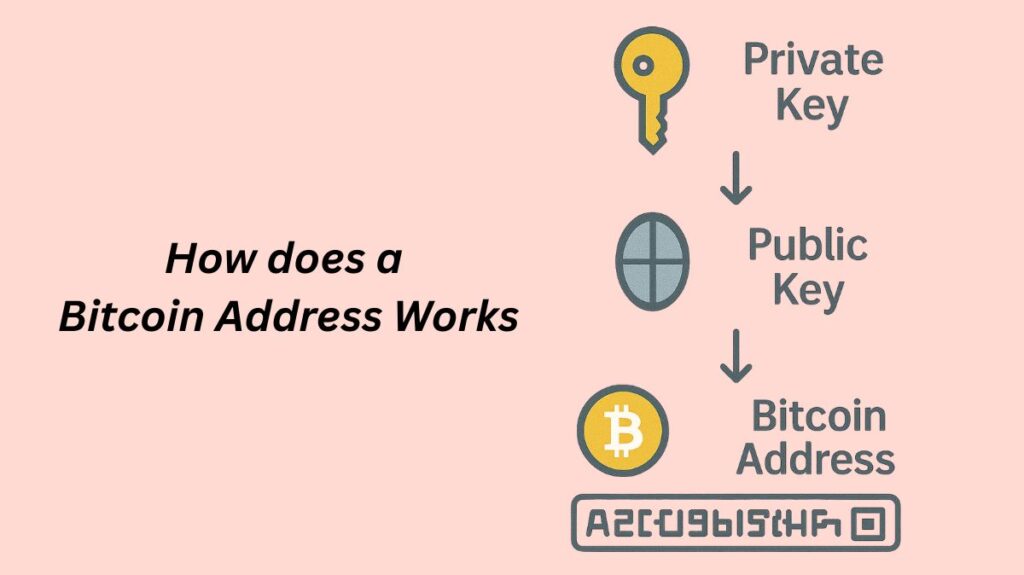What is a Bitcoin address

A Bitcoin address is a special combination of letters and digits that serves as a digital identity for Bitcoin recipients. Like a bank account number for receiving money or an email address for sending messages, it has a similar function.
A thorough analysis of Bitcoin addresses may be found here:
Definition and Purpose
In essence, a Bitcoin address is a publicly visible identification within the Bitcoin blockchain network. Designating senders and recipients in a transaction is its main function, enabling users to transmit and receive digital assets. The recipient’s Bitcoin address is required in order to transfer them Bitcoin. Since anyone with the string can send Bitcoin to the owner of the address, Bitcoin addresses are essential for both sending and receiving the cryptocurrency. They guarantee that transactions are routed and carried out appropriately inside the blockchain network and that money is transferred to the appropriate Bitcoin wallet.
How does a Bitcoin Address Works and its Relationship with Keys

Private and public cryptographic keys are closely related to how a Bitcoin address works.
Private Key: The key to your money is this lengthy, arbitrary, and confidential number. It lets you approve transactions and spend your Bitcoin, thus you should never share it. Your wallet creates a digital signature using your private key to validate a transaction and prove ownership.
Public Key: The Elliptic Curve Digital Signature Algorithm (ECDSA), which is based on the SECP256K1 standard, is a one-way cryptographic mechanism that uses your private key to generate a public key instead. Since this process is irreversible, the private key cannot be obtained from the public key. Although payments could previously be transferred straight to public keys (P2PK), Bitcoin addresses are now the preferred method because to their increased interoperability, privacy, and security.
Bitcoin Address: The public key is used to generate the Bitcoin address via a sequence of cryptographic operations. It is a legible and easy-to-use version of the hash for your public key. It is safe to disclose your Bitcoin address because it does not divulge your private key, even though you can freely use it to receive money. Public keys or addresses are used to track and receive cash, while wallets employ the private key to control access to assets on the blockchain rather than storing currency.
Creation Process (Address Derivation)
There are multiple cryptographic procedures involved in creating a Bitcoin address:
Generate a Private Key: The private key is a randomly generated 256-bit integer.
Derive a Public Key: Using ECDSA, the public key is obtained from the private key.
First Hash (SHA-256): A cryptographic hash function called SHA-256 is used to hash the public key.
Second Hash (RIPEMD-160): Following the SHA-256 hash, the RIPEMD-160 hash function is used to hash the result once more. The address is made shorter and more secure by this technique.
Add Version Number: This 160-bit hash has a version number attached to it.
Third and Fourth Hashes (SHA-256): SHA-256 hashes the result twice times.
Extract Checksum: An address checksum is made up of the first four bytes of the result of the fourth hash. The purpose of this checksum is to help identify any errors that may occur when copying or inputting the address.
Append Checksum: The RIPEMD-160 hash has the checksum applied to it.
Encode (Base58Check/Bech32): This byte string is then encoded into either the Bech32 or Base58Check formats. By preventing confusion between characters that seem identical (such as 0, O, I, and l), Base58Check encoding makes sure that the string is readily accepted as input.
A Bitcoin address that may be disclosed publicly without jeopardising the confidentiality of the private key is produced by this technique.
Properties and Characteristics
- Typically, Bitcoin addresses consist of 26–35 characters.
- Because of their initial character or characters, they are easily recognised.
- While public keys are longer, addresses are shorter.
- When typing or copying lengthy addresses, it can be easier to avoid errors by converting an address into a QR code for usage on mobile devices.
Types of Bitcoin Addresses
In order to increase usefulness, security, and efficiency, Bitcoin addresses have changed. Differentiated by their initial characters, there are four primary categories:
Legacy (P2PKH – Pay-to-Public-Key-Hash):
- Starts with the letter “1.”
- These are the first and most popular Bitcoin addresses.
- They have greater transaction fees and are less effective than more recent versions.
- protected by the SHA-256 algorithm.
- Example: 1A1zP1eP5QGefi2DMPTfTL5SLmv7DivfNa.
Nested SegWit (P2SH – Pay-to-Script-Hash):
- Starts with the letter “3.”
- Created to make more complicated transactions possible, such multi-signature wallets.
- Transaction fees are cheaper than with Legacy addresses.
- Compatible with previous wallet versions.
- Example: 3J98t1WpEZ73CNmQviecrnyiWrnqRhWNLy.
Native SegWit (Bech32/P2WPKH – Pay to Witness Public Key Hash):
- Starts with “bc1q”.
- The most effective and most popular kind of new wallets.
- Improves mistake detection and has the lowest transaction fees.
- Not all older wallet software can use it.
- Supports Segregated Witness (SegWit), which makes transactions smaller and permits more transactions per block, resulting in quicker confirmations and cheaper fees. The Lightning Network is also made possible by SegWit.
- Employ error-correcting codes and are case-insensitive, which increases their resistance to input errors.
- Example: bc1qsr03qya584vkdqztxyat3d5s63pjfddy8vwrue.
Taproot (Bech32m/P2TR – Pay to Taproot):
- Starts with the words “bc1p.”
- The Taproot upgrade brought in the newest address type.
- Offers improved productivity and privacy.
- By making complex transactions (like multi-signature smart contracts) look like straightforward single-signature transactions on the blockchain, privacy is improved and expenses are decreased.
- Example: bc1pc52e90846uvd8p27ce75j7cv2fsqn2h8fclsah50v7kx4puhkkqqf27ax2.
P2WSH (Pay to Witness Script Hash):
- P2SH variation that generates addresses beginning with the prefix bc1q.
- Addresses consist of 62 characters.
- Designed to support multisignature setups, reduce transaction fees, and provide further security by utilizing SHA-256.
Users can choose the type of address to use and manage their Bitcoin addresses with wallet apps.
Usage in Transactions
It is necessary to use a Bitcoin address in order to transfer and receive Bitcoin.
Receiving Bitcoin:
- Generate an address: Choose the “Receive” option in your Bitcoin wallet app to see one of your addresses.
- Share your address: Copy the address or show the sender the address as a QR code.
- Receive funds: After entering the amount, setting a fee, and broadcasting the transaction, the sender copies or scans your address into their wallet.
Sending Bitcoin:
- Prepare to send: Make sure you have enough money in your wallet before clicking “Send”.
- Scan or paste the address: In your wallet app, scan or copy the recipient’s Bitcoin address. It is important to confirm that the address is correct.
- Enter an amount: Broadcast the transaction after choosing the amount to transmit and establishing a charge.
A transaction is usually included to a blockchain block within minutes of being broadcast. The recipient’s wallet tracks the transaction and keeps an eye on the blockchain. Once the transaction has been “confirmed” (added to a block), the balance in the recipient’s wallet is updated. The Bitcoin is then owned by the recipient because only their private keys may approve its use. Money transferred to the incorrect address is probably lost forever because Bitcoin transactions are irrevocable and permanent once they are published to the blockchain.
Key Security and Privacy Points
Private Key Security: The secret password to your money is your private key, which you should never divulge. You will not be able to access your Bitcoin if you lose it or it is compromised.
Irreversible Transactions: All Bitcoin Transactions are final. Bitcoin has no return mechanism like typical bank transactions, so if you send it to the wrong address, the money is probably gone forever. Make sure the address is correct before sending.
Reusing Addresses: For privacy reasons, it is not advised to reuse Bitcoin addresses, even though it is technically possible. For the purpose of protecting your identity and obscuring your transaction history, many wallets automatically create a new address for every transaction. Despite the fact that Bitcoin users can employ pseudonyms, all transactions are available to the public, and methods for connecting addresses to actual people exist.
Custody: The establishment and management of addresses are taken care of for you by custodial services (like as Coinbase and Strike). Understanding Bitcoin addresses is crucial when assuming self-custody with a non-custodial wallet, though, because you still keep possession of the keys.
Address Lookups: Users can view and confirm funds connected with a Bitcoin address, including transaction history and confirmation status, by simply inputting the address into free web tools (such as CoinTracker, BitRef, and Blockonomics). These technologies extract publicly accessible blockchain data without requiring passwords or user logins, protecting privacy.
Evolution of Security: Bitcoin addresses were created as a safer substitute for transmitting money to IP addresses directly, which was vulnerable to man-in-the-middle attacks. By making it nearly impossible to derive the private key, hashing methods and asymmetric encryption in addresses protect transactions.
